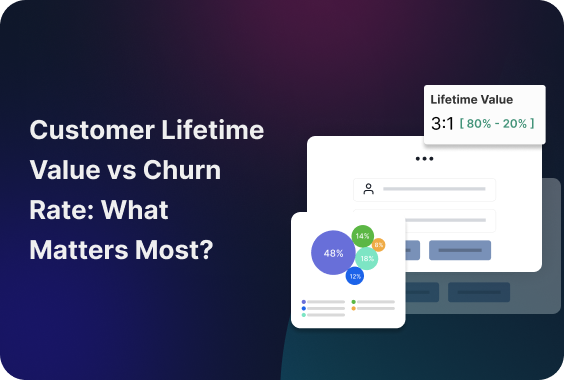Customer Lifetime Value vs Churn Rate are exceptional membership metrics that are deeply connected. Want to understand how in detail? Well, here’s a solid guide that would equip you with everything you need to spark up your business and keep the members satisfied.
In our Customer Lifetime Value vs Churn Rate difference guide, we try to shed some light on these terms, provide you with effective formulas, explain what factors directly influence these rates, and key metrics that matter, especially for membership and subscriptions businesses that live on recurring revenue!
What is Churn Rate and Why Does It Matter?
Churn rate is crucial for many businesses, especially for subscription and membership solutions. If members cancel, your predictable income drops. Even small increases in churn are dangerous for long-term success. What’s worse – even if you’re getting new people in the door, a churn rate really holds things back!
Churn rate is calculated as the percentage of customers who, simply put, abandon your services by canceling or stopping using your solutions during a specified period.
Even though this guide is not for mathematicians, a few easy marketing formulas will be presented here and there, and they do exist to help your understanding of the terms! And let’s start with the first one:
Churn Rate Formula:
Churn Rate = (Customers Lost During Period ÷ Total Customers at Start of Period) × 100
Simply put: the higher the churn, the more customers you’re losing.
Retention is one of the most valuable metrics, and churn rate is a direct indicator of it. The higher churn rate, you’re losing people faster than you’re gaining them.
If you deal with content-based memberships (e.g., online courses, paid communities), high churn probably means that the content is not engaging enough or that people don’t see any value in continuing to use your products.
Customer Lifetime Value vs Churn Rate example: Reducing churn from 10% to 5% can double customer lifetime and significantly increase CLV.
For memberships with the subscription-based model, churn is often driven by:
- Outdated or irrelevant content.
- Inconsistent publishing schedules.
- Lack of perceived progress or value.
Churn directly affects Customer Lifetime Value (more on this below).
Customer Lifetime Value vs Churn Rate example: Since acquisition costs are often high, low CLV can make your business unsustainable.
At the same time, consider low churn a strong foundation for growth. What can you do – reinvest in better content? Build a support team? Improve your marketing? These are things to explore for you.
What is Customer Lifetime Value?
Customer Lifetime Value, or famously known as CLV or CLTV, is an exclusive and important business metric if you’re a business dealing with multiple customers.
For instance, a specific set of customers are expected to pay regularly during a certain period. Now, a customer’s lifetime value or the worth of each customer can be calculated for that period for your business. Very simply, it is the amount of money a customer is going to pay you during a particular tenure.
However, there are certain businesses for which CLTV is more crucial than others. They are as follows:
- Recurring or subscription-based businesses (memberships, gyms, streaming services).
- Restaurants, cafes, vacation rentals, and other hospitality industries.
- Service industries and businesses that rely on appointments, like salons, auto repair shops, or fitness trainers.
- Sales and maintenance for the automobile industry.
While recurring revenue is a similarity for all the variety of these business types, revenue patterns, customer behaviors, and costs vary – that’s why there might be different CLV formulas for calculating them. Let’s highlight some of them below.
Key Customer Lifetime Value Formulas for Different Businesses
Here are the key metrics and formulas. Note that you may find some of them from other businesses still relevant!
Membership businesses with paid subscriptions, online and offline:
Those include content-based membership sites, SaaS, gyms, and streaming services. CLV is often easier to predict based on clear subscription fees and the regularity of payments.
CLV Formula:
CLV = Average Monthly Revenue per Customer × Average Customer Lifespan (in months)
Or an alternative formula for memberships:
CLV = Average Monthly Revenue per Member × Average Retention in Months × Gross Margin
Extensions to the formula that may apply to your business:
- Include upsells (events, add-ons).
- Include referral value
- Deduct Customer Acquisition Cost (CAC) for net CLV
Monthly Recurring Revenue types –
- New MRR: Revenue from new customers added this month.
- Expansion MRR: Revenue from upgrades, add-ons, or cross-sells.
- Churned MRR: Lost revenue from cancellations or downgrades.
- Net MRR: Total MRR after accounting for churn and expansion.
Key Metric:
Churn rate is crucial here. Small changes in retention can have a big impact on CLV.
Service businesses, including salons, consultants, personal trainers:
Clients may visit weekly, monthly or even yearly. So, here it’s important to keep track of all those visits and include them into the formula.
CLV Formula:
CLV = Average Revenue per Visit × Visits per Year × Average Customer Lifespan
Key Metric:
Booking frequency and retention. Reminder systems and follow-ups help here.
Churn here is often gradual, not sudden, because of things like gaps between bookings. It might be more important to consider the time since your last visit as a churn signal, rather than cancellation. In this niche, for better CLV prediction, the recency-frequency-monetary (RFM) analysis is often used.
Moreover, while formulas are a helpful data-driven foundation, real insights for the customer’s lifetime always go beyond simple formulas.
Are Customer Churn and Revenue Churn Similar?
These two are closely related; however, two different metrics. Many times, they’re used interchangeably, but they convey different meanings.
- Customer Churn is the percentage of customers who completely stop doing business with you during a certain period. It reflects the number of users who left, regardless of the amount you were receiving from them.
- Now, for Revenue Churn, it looks at the monetary value lost due to the loss of members. Thus, it looks at the overall picture of the amount that your business loses. It accounts for high-value and low-value customers, both.
Why it matters:
For instance, your churn rate for the month is 2 members. It’s not that big a deal, right? But, one customer was paying $10/month while the other was paying $1000/month. Technically, you lose two customers, but when you look at the revenue loss, it’s huge. To understand the financial impact of losing customers, the revenue churn rate is important.
Revenue Churn Rate formula:
Revenue Churn Rate = (MRR Lost from Existing Customers ÷ Total MRR at Start of Period) × 100
How to Improve Your Understanding of CLV vs Churn Rate for Memberships & Subscriptions
Membership subscription businesses that use monthly or annual billing can ease calculations. However, for this type of business monetization, churn rate is critical and even small changes in churn may influence your CLV. Here are more things to understand:
- Churn is sensitive data because it’s not always final – clients can cancel their membership and then return. In addition to cancellations, monitor passive churn (failed payments, inactivity).
- For content-based businesses, engagement is key; that’s why low usage = high churn.
- Time to value is another crucial metric.
- The onboarding experience of your membership site directly affects CLV, so the entry-level price is not the final.
- Consider how satisfied members may take part in referral programs, or if friend discounts play a role (for some businesses, a referral value can be included in the CLV formula).
- If your payment systems use payment methods with recurring subscriptions, consider that billing errors are a major source of churn.
- Segment your CLV by cohort (e.g., trial users vs. committed members) for more accuracy because many memberships lose clients in the first 1–3 months.
How do offline and online memberships compare? Compare some key nuances.
| Feature | Online memberships | Offline memberships |
|---|---|---|
| Scalability | High (digital delivery) | Limited (physical space/resources) |
| Churn | Fast and frictionless (1-click cancel) | In-person friction may reduce churn |
| Engagement tracking | Precise (logins, clicks, usage) | Harder to track (attendance logs) |
| Cost to serve | Low (after setup) | Higher (staff, rent, utilities) |
As for boosting your CLV for memberships and subscriptions for an online business, consider these factors:
- High login or attendance frequency.
- Engaging with support/community.
- Using premium features.
- Subscribing annually instead of monthly.
Top Strategies to Reduce Churn Rate
Check out the following proven strategies to reduce your churn rate and retain members to increase their lifetime value.
- Improve the Onboarding experience with tutorials, welcome emails, and walkthroughs to avoid any early confusion or friction.
- Track engagement regularly and keep working on it. Send automated check-ins or incentives to boost a member who’s been MIA.
- Ensure providing value as soon as possible. Like knowledge increase, benefits, or mini milestone achievement.
- Set up feedback loops to understand users’ expectations and improve your offering.
- Add annual plans, as these drastically reduce the churn rate and improve cash flow.
- Add a loyalty and rewards program to give exclusive perks and discounts to members.
- Automate payment systems to avoid any failed payments or renewals.
To Sum Up on Customer Lifetime Value vs Churn Rate
If you are asking ‘Customer lifetime value vs churn rate: what matters most?’, the answer is: they are closely connected, they are both highly important for your revenue prediction decisions. A churn rate directly impacts customer lifetime, and together they shape your long-term profitability forecasting plan. Higher churn = shorter average customer lifespan = lower CLV. The smaller the churn, the easier to calculate the customer lifetime value.
And most importantly, remember that members stay when content solves real problems or provides ongoing learning, value, or entertainment.
Related articles:






